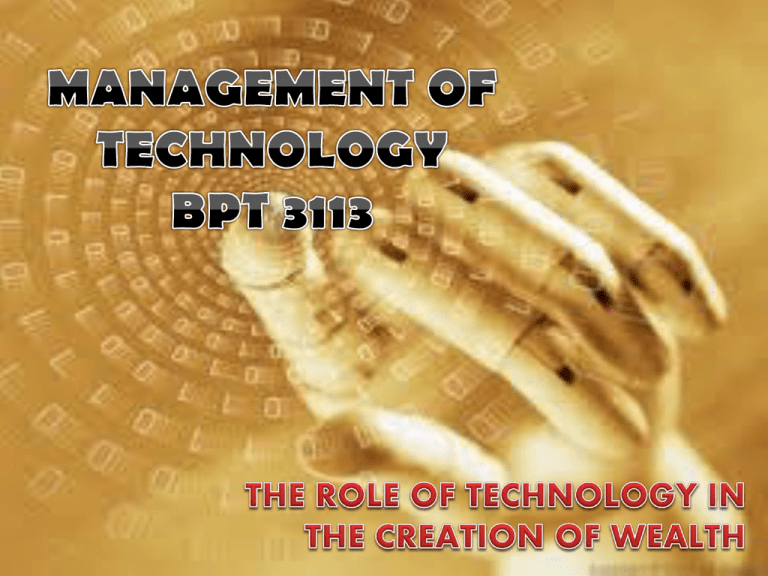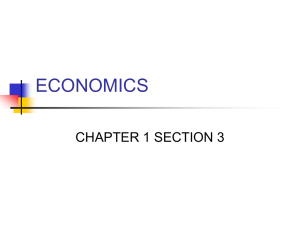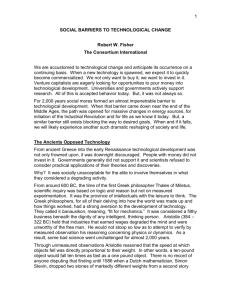Management of (information) Technology
advertisement

• • • • • • Evolution By Age of Technology The Creation of Wealth The Evolution of Production Technology The Evolution of Product Technology Technology Role in Organization Technology and National Economy • Identify the evolution of technology • Explain how technology role important to the creation of wealth Progress of civilization is frequently identified by the dominant technology of the age The stone age The bronze age The iron age The steam power age The electricity age The nuclear power age The electronics age The aerospace age The information age The biotechnology age Technology generates wealth when it is commercialized or used to achieve a desired strategic or operational objective for an organization. Spinning Out Technology • Adam Smith (British economist, 18th century) : – Economic Wealth (EW) is produced and distributed – Argued that capital is best employed for the production of wealth – Each nation should produce the goods in which it has absolute advantage • Joseph Schumpeter (German economist, 1928) : – EW is characterized by private initiative, by production for a market and by a phenomenon of credit – He also showed that industrial expansion is also the result of economic forces • Meanwhile, many economists determined economic growth by the rate of change in per capita real GDP • Robert Solow (1987 Nobel Prize in Economics) indicates that technological development will be the motor for EW in the long run • Boskin & Lau (1992) indicate that 3 principal sources of EW are enhanced capital, labor and technical progress • U.S National Science & Technology Council (1996) emphasized that technology is the engine of EW. It reported that “performance of individual companies is strongly linked to their use of technology” Other factors that contribute to the wealth-creation system Natural Resources Technology Market Wealth Creation Public & Environmen tal Policy Labor Capital • Improvement in productivity is vitally important to an economic system – technology is the driver • Emerging and new technology spurs economic expansion known as the long-wave or long economic cycle • Betz (1987) suggested that the process behind it is an interaction between technology, business opportunities the new technology creates and an eventual overbuilding of capital after the technology ages. Discoveries in science Phenomenal base for technological innovation Creates new products Creating excess production capacity Expanding markets Create new markets & industries Decrease profitability and increase business failures May lead to depressions New science & technology provide basis new economic expansion • Cutting-edge technology is behind the long waves of economic activity. • High-technology products displace old technology when there is a justification for performance over cost. • Technology life cycles of industries affect long cycles in the national economy. • New technology comes from science and science comes from new discoveries in nature. • A new technology, when created, will began a new wave. 1880 • Agriculture Society – manual labor dominated • The Industrial Revolution – factory concept was born 1880 > • • • • Scientific Management – introduced by Frederick Taylor Times Studies & Mass Production Division of Labor, Labor Unions Standardization, Assembly Line – introduced by Henry Ford 1900 > • Organizational Concepts • Motion Study – introduced by Frank & Lillian Gilbreth • Piecework 1920 > • Production Control & Management Planning • Queuing, Wage Incentive, Management Planning • Statistical Quality Control (SQC) – introduced by Deming & Juran 1940 > • Tool Design, Human Factors • Productivity, Engineering Economy • Inventory Theory, Layout, Material Handling 1950 > • Computerization, Reliability • Operational Research • Statistical Analysis, Network Techniques 1960 > • Automation, System Design, Teleprocessing • Information Systems, Decision Theory, Simulation • System Engineering, Optimization Theory 1970 > • Control Theory, Large Scale System • Total System Design, Social System, Cybernetics • Behavioral Theory, Personal Computers 1980 > • Technology Revolution • Management of Technology 1793 - 1829 • Cotton gin (Whitney) • Practical Steamboat (Fulton) • Steam Powered Locomotive for passengers and freight 1830 - 1900 • Telegraph (Morse), Improved plow (Deere) • Vulcanized Rubber, Internal Combustion Engine • Telephone (Bell), Radio (Marconi) 1901 - 1939 • Air Conditioner, FM Radio • First Flight (Wright Bros.), Model T (Ford) • Helicopter, Jet Engine, Liquid-Fueled Rockets 1940 - 1949 • Color TV, Electronic Appliance • Digital Computer, Instant Camera • Jet Airliner, Transistor, Supersonic Flight 1950 - 1969 • Sputnik 1 (USSR), NASA, Apollo XI • Integrated Circuit, Operable Laser, Fiber Optics • Telstar Satellite, First Man in Space 1970 onwards • Microprocessor, Recombinant DNA • Laser Printer, MRI Scanner, Space Shuttle • Scanning Tunneling Microscope 1. Provides Sustainable Competitive Advantage 2. Increases Productivity 3. Creates Profits 4. Protects from Obsolescence 5. Achieves Business-Market Fit 6. Enhances Motivation and Potential of Employees 7. Engine of Economic Growth 8. Improves Quality of Life • Developed economies – countries that properly use technology for the creation of wealth • Less developed economies – countries lacking the technological know-how necessary to create wealth • U.S has the greatest technological edge in the world but Japan & Germany have manage their resources and technological systems better (achieved economic advantage) • • • • • • • • Formulate policies to promote technology Place strategic focus on right technology Build technological capabilities Safeguard interests of society Provide resources Strengthen education and entrepreneurship Set up appropriate legal frame work Establish networks • Not the technology itself create the wealth – it is the appropriate and effective use of such technology • Wealth is created on the basis of technology, production and smart work Proper management of low or medium level technologies can still create a certain competitive advantage and be effectively used for wealth creation. In support of this point, one can observed the economic growth of newly industrialized countries (NICs), particularly those called the tigers of Asia such as Taiwan, Korea, Singapore and Malaysia. These countries have succeeded in acquiring low or medium level technologies and have done a credible job in managing technological resources. What strategy was followed by that country to become a competitor? Discussed the points. Strategy that been used to become competitor: 1. Cheaper labor 2. Fewer regulatory restrictions 3. Strategic geographical location 4. Focusing niches where it can prosper 5. Excellent infrastructure 6. Stable currency









